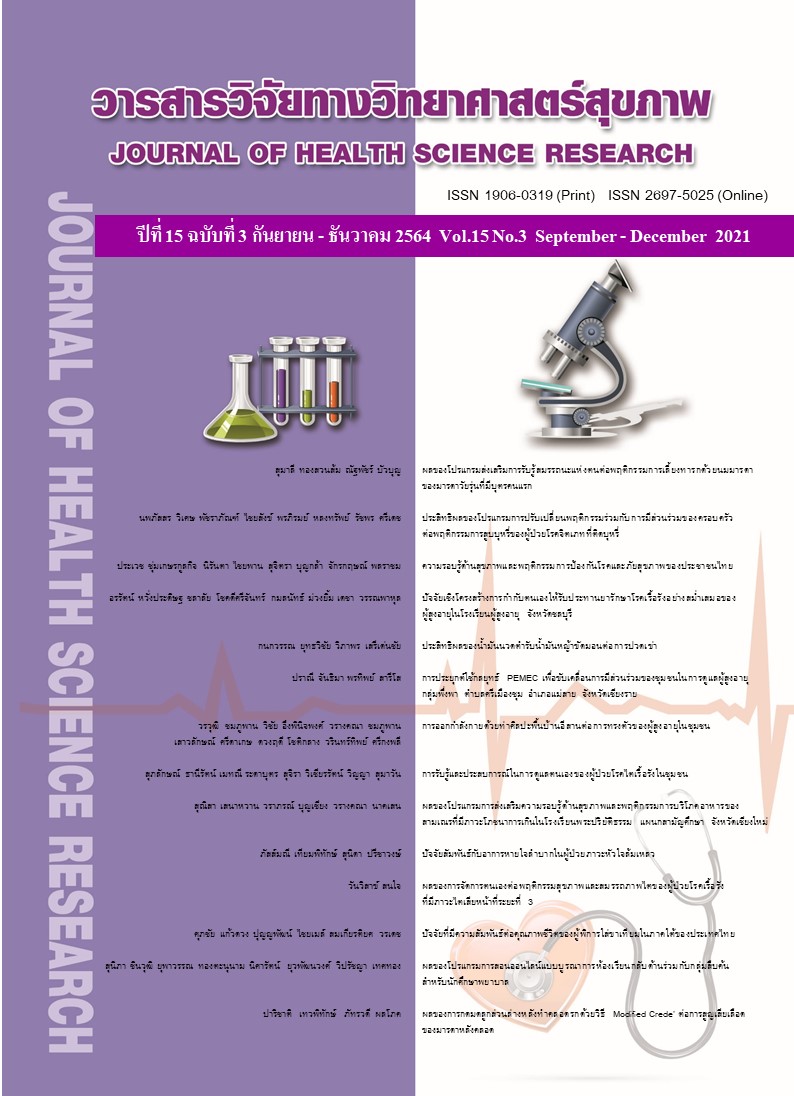การออกกำลังกายด้วยท่าศิลปะพื้นบ้านอีสานต่อการทรงตัวของผู้สูงอายุในชุมชน
Main Article Content
บทคัดย่อ
บทนำ : ประชากรสูงวัยเพิ่มขึ้นทั่วโลกรวมถึงประเทศไทย ผู้สูงอายุมีการเปลี่ยนแปลงด้านสรีรวิทยา ส่งผลให้เกิดการเจ็บป่วย เสียสมดุลในการทรงตัวลดลงและเสี่ยงต่อการหกล้ม
วัตถุประสงค์การวิจัย : เพื่อศึกษาผลของการออกกำลังกายด้วยท่าศิลปะพื้นบ้านอีสานต่อการทรงตัว ความดันโลหิต และอัตราการเต้นของหัวใจในผู้สูงอายุ
วิธีการวิจัย : งานวิจัยกึ่งทดลอง ศึกษากลุ่มผู้สูงอายุในชุมชนเขตจังหวัดขอนแก่น แบ่งเป็นกลุ่มทดลองและกลุ่มเปรียบเทียบกลุ่มละ 40 คน กลุ่มทดลองได้รับการออกกำลังกายนาน 3 เดือน กลุ่มเปรียบเทียบดำเนินชีวิตตามปกติโดยไม่เกี่ยวข้องกับโปรแกรมการทดลอง เก็บรวบรวมข้อมูลก่อนและหลังการทดลองโดยใช้การทดสอบการทรงตัวด้วยวิธีลุกเดินจากเก้าอี้ วิธีการเอื้อมมือ โดยการเปรียบเทียบค่าเฉลี่ยของข้อมูลภายในกลุ่มและระหว่างกลุ่มโดยใช้สถิติทดสอบค่าที กำหนดระดับนัยสำคัญทางสถิติที่ .05
ผลการวิจัย : พบว่ากลุ่มทดลองมีการทรงตัวซึ่งทดสอบด้วยวิธีลุกเดินจากเก้าอี้ไปและกลับ เร็วขึ้น 2.09 วินาที (95%CI = 0.89 - 3.30) และยังพบว่าการทดสอบการเอื้อมมือที่เพิ่มมากขึ้น 4.98 เซนติเมตร (95%CI = 3.70 - 6.25) แตกต่างจากกลุ่มเปรียบเทียบอย่างมีนัยสำคัญทางสถิติ (p<.05)
สรุปผล : การออกกำลังกายด้วยท่าศิลปะพื้นบ้านอีสานส่งผลต่อการทรงตัวของผู้สูงอายุดีขึ้นรวมไปถึงการมีความดันโลหิต และอัตราการเต้นของหัวใจที่ลดลง
Downloads
Article Details
บทความที่ได้รับการตีพิมพ์เป็นลิขสิทธิ์ของวิทยาลัยพยาบาลบรมราชชนนี จังหวัดนนทบุรี
ข้อความที่ปรากฏในบทความแต่ละเรื่องในวารสารวิชาการเล่มนี้เป็นความคิดเห็นส่วนตัวของผู้เขียนแต่ละท่านไม่เกี่ยวข้องกับวิทยาลัยพยาบาลบรมราชชนนี จังหวัดนนทบุรี และคณาจารย์ท่านอื่น ในวิทยาลัยฯ แต่อย่างใด ความรับผิดชอบองค์ประกอบทั้งหมดของบทความแต่ละเรื่องเป็นของผู้เขียนแต่ละท่าน หากมีความผิดพลาดใด ๆ ผู้เขียนแต่ละท่านจะรับผิดชอบบทความของตนเองแต่ผู้เดียว
เอกสารอ้างอิง
United Nations, Department of Economic and Social Affairs, Population Division: World Population Ageing 2019 Highlights; 2019.
Foundation of Thai Gerontology Research and Development institute (TGRI): Situation of the Thai Elderly 2018. Bangkok: Amarin printing and publishing; 2019. (in Thai).
Forman DE, Arena R, Boxer R, Dolansky MA, Eng JJ, Fleg JL, et al. Prioritizing functional capacity as a principal end point for therapies oriented to older adults with cardiovascular disease: A scientific statement for healthcare professionals from the American Heart Association. Circulation. 2017;135(16):894-918. doi: 10.1161/CIR. 0000000000000483.
Lord SR, Delbaere K, Gandevia SC. Use of a physiological profile to document motor impairment in ageing and in clinical groups. J. Physiol. 2016;594(16):4513-23. doi: 10.1 113/JP271108.
Yang Y, Komisar V, Shishov N, Lo B, Korall AM, Feldman F, et al. The effect of fall biomechanics on risk for hip fracture in older adults: A cohort study of video-captured falls in long-term care. J Bone Miner Res. 2020;35(10):1914-22. doi: 10. 1002/jbmr.4048.
Chompoopan W, Chompoopan W, Eungpinichpong W, Eungpinichpong W. Effects of low intensity exercises on body balance and muscle strength of community elderly people. Int. J. GEOMATE. 2019; 17(61):86-90. doi: 10.21660/2019.61.4786.
Sung WH, Liu CC, Wei SH, Chuang LR, Chuang E, Wang KA, et al. Feasibility and outcome of an individualized Tai Chi program for improving balance and strength in the elderly: A pilot study. NeuroRehabilitation. 2018;43(4):509-18. doi: 10.3233/NRE-162061.
Kocic M, Stojanovic Z, Nikolic D, Lazovic M, Grbic R, Dimitrijevic L, et al. The effectiveness of group Otago exercise program on physical function in nursing home residents older than 65 years: A randomized controlled trial. Arch Gerontol Geriatr. 2018;75:112-8. doi: 10.1016/j. archger.2017.12.001.
Alghadir AH, Al-Eisa ES, Anwer S, Sarkar B. Reliability, validity, and responsiveness of three scales for measuring balance in patients with chronic stroke. BMC Neurol. 2018;18(1):141. doi: 10.1186/s12883-018-1146-9.
Puengtanom S, Suttanon P. Psychometric properties of falls risk assessment in older people with mild cognitive impairment and dementia: A systematic review. Vajira Medical Journal: Journal of Urban Medicine. 2018;62(4):335-44. (in Thai).
Reguera-García MM, Leirós-Rodríguez R, Fernández-Baro E, Álvarez-Barrio L. Reliability and validity of the six spot step test in people with intellectual disability. Brain Sci. 2021;11(2):201. doi:10.3390/brainsci11020201.
Sriraksa C, Nakmareong S, Yonglitthipagon P, Siritaratiwat W, Sawanyawisuth K, Janyacharoen T. Effects of Isaan dance on physical performance in elderly Thais: A pilot study. Chulalongkorn Medical Journal. 2018;62(2):211–22. (in Thai).
Lapanantasin S, Techovanich W, Na Songkhla P, Odglun Y, Wikam S. Balance performance and fear of fall improvement for elderly women living in Ongkharak and Bang-lookseir subdistrics of Nakhonnayok province by a community-based service. Thai Journal of Physical Therapy. 2015;37 (2):63-7. (in Thai).
Leitzelar BN, Koltyn KF. Exercise and neuropathic pain: A general overview of preclinical and clinical research. Sports Med Open. 2021;7(1):21. doi: 10.1186/s 40798-021-00307-9.
Eches EH, Ribeiro AS, Gerage AM, Tomeleri CM, Souza MF, Nascimento MA, et al. Twenty minutes of post-exercise hypotension are enough to predict chronic blood pressure reduction induced by resistance training in older women. Motriz: Rev. Educ. Fís. 2018; 24(1):1-7. doi: 10.1590/S1980-657420 1800010005.
Coelho-Júnior HJ, Asano RY, Gonçalvez IO, Brietzke C, Pires FO, Aguiar SDS, et al. Multicomponent exercise decreases blood pressure, heart rate and double product in normotensive and hypertensive older patients with high blood pressure. Archivos de cardiología de México. 2018;88(5):413-22. doi: 10.1016/j.acmx. 2018.01.001.
Aprile DC, Oneda B, Gusmão JL, Costa LA, Forjaz CL, Mion D Jr, et al. Post-exercise hypotension is mediated by a decrease in sympathetic nerve activity in stages 2-3 CKD. Am J Nephrol. 2016;43(3):206-12. doi: 10.1159/000445443.
Tsukiyama Y, Ito T, Nagaoka K, Eguchi E, Ogino K. Effects of exercise training on nitric oxide, blood pressure and antioxidant enzymes. J Clin Biochem Nutr. 2017; 60(3):180-6. doi: 10.3164/jcbn.16-108.
Conti V, Russomanno G, Corbi G, Izzo V, Vecchione C, Filippelli A. Adrenoreceptors and nitric oxide in the cardiovascular system. Front Physiol. 2013;4:321. doi: 10.3389/fphys.2013.00321.


